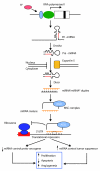Non-coding RNAs: a key to future personalized molecular therapy?
- PMID: 20236487
- PMCID: PMC2847703
- DOI: 10.1186/gm133
Non-coding RNAs: a key to future personalized molecular therapy?
Abstract
Continual discoveries on non-coding RNA (ncRNA) have changed the landscape of human genetics and molecular biology. Over the past ten years it has become clear that ncRNAs are involved in many physiological cellular processes and contribute to molecular alterations in pathological conditions. Several classes of ncRNAs, such as small interfering RNAs, microRNAs, PIWI-associated RNAs, small nucleolar RNAs and transcribed ultra-conserved regions, are implicated in cancer, heart diseases, immune disorders, and neurodegenerative and metabolic diseases. ncRNAs have a fundamental role in gene regulation and, given their molecular nature, they are thus both emerging therapeutic targets and innovative intervention tools. Next-generation sequencing technologies (for example SOLiD or Genome Analyzer) are having a substantial role in the high-throughput detection of ncRNAs. Tools for non-invasive diagnostics now include monitoring body fluid concentrations of ncRNAs, and new clinical opportunities include silencing and inhibition of ncRNAs or their replacement and re-activation. Here we review recent progress on our understanding of the biological functions of human ncRNAs and their clinical potential.
Figures

References
-
- Calin GA, Liu CG, Ferracin M, Hyslop T, Spizzo R, Sevignani C, Fabbri M, Cimmino A, Lee EJ, Wojcik SE, Shimizu M, Tili E, Rossi S, Taccioli C, Pichiorri F, Liu X, Zupo S, Herlea V, Gramantieri L, Lanza G, Alder H, Rassenti L, Volinia S, Schmittgen TD, Kipps TJ, Negrini M, Croce CM. Ultraconserved regions encoding ncRNAs are altered in human leukemias and carcinomas. Cancer Cell. 2007;12:215–229. doi: 10.1016/j.ccr.2007.07.027. - DOI - PubMed
LinkOut - more resources
Full Text Sources
Other Literature Sources
Miscellaneous

